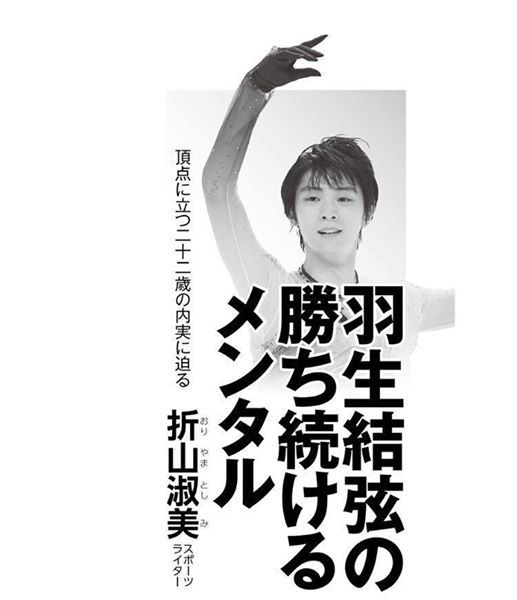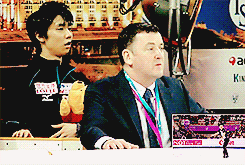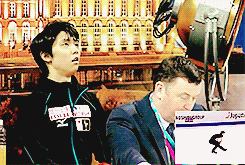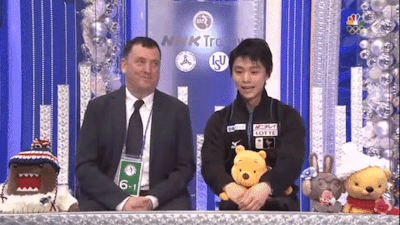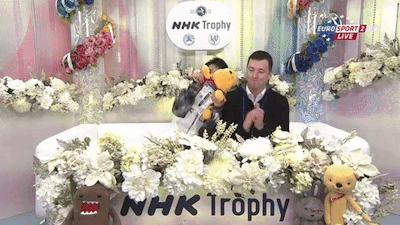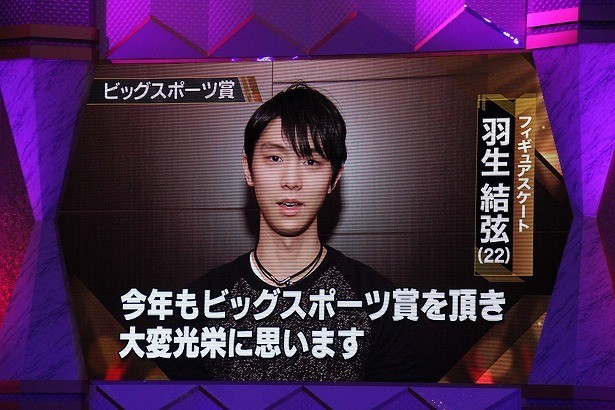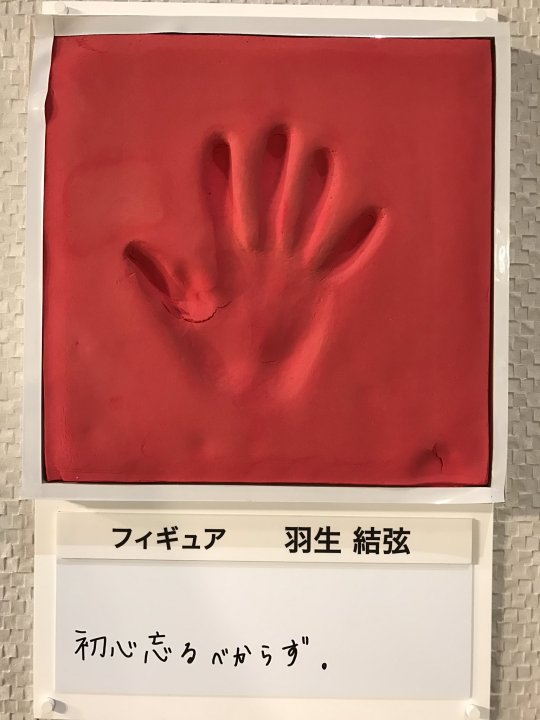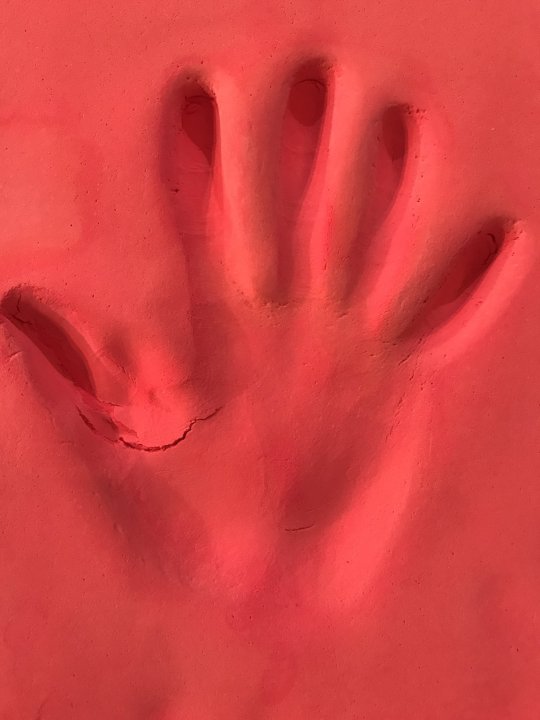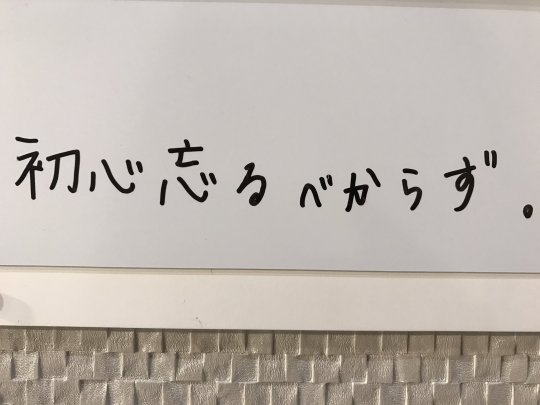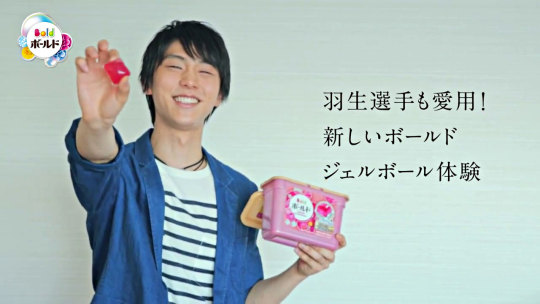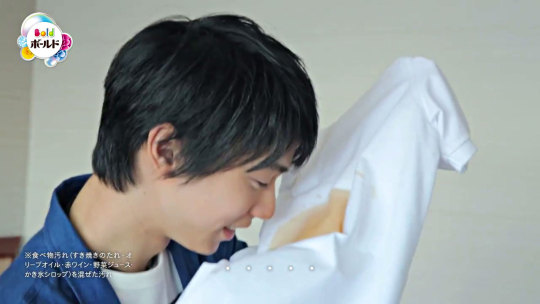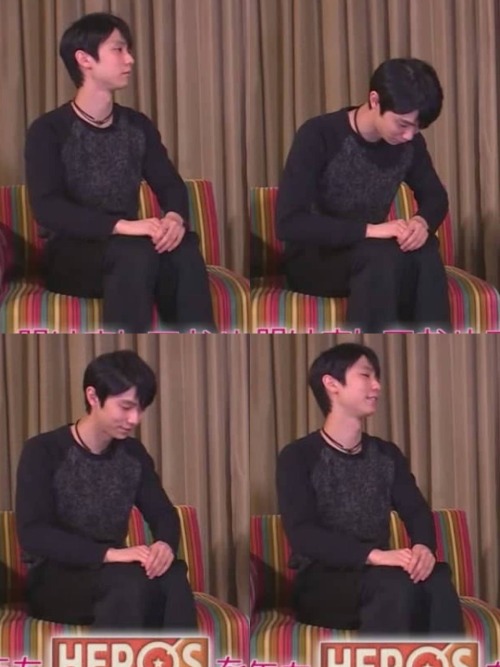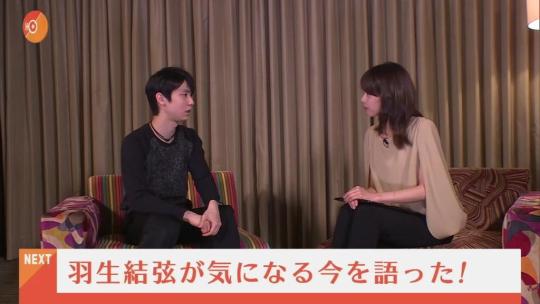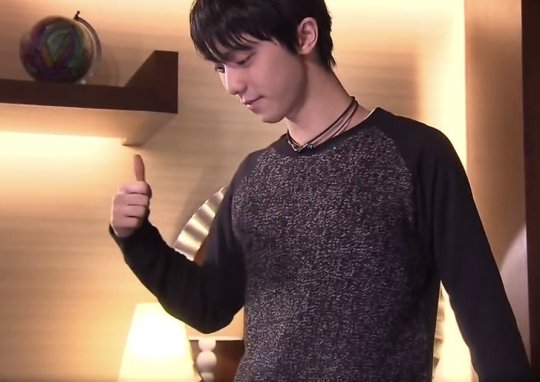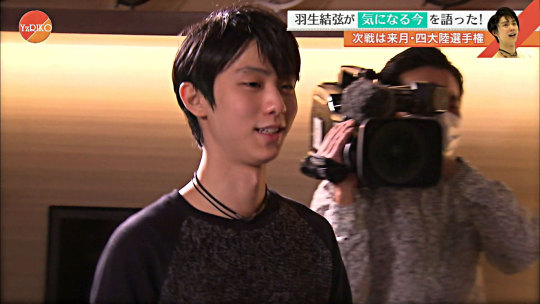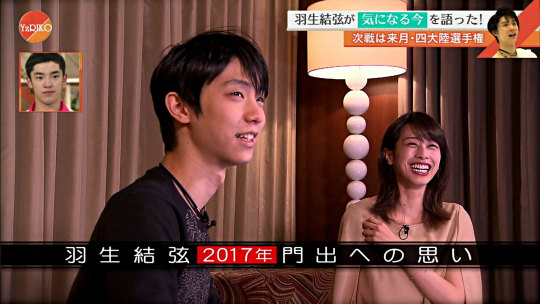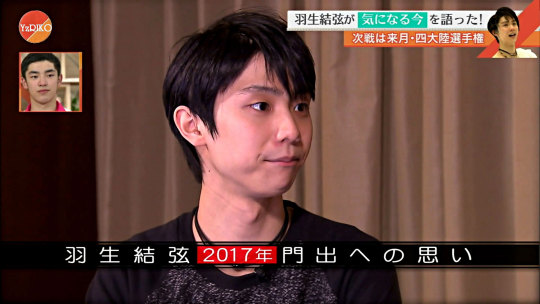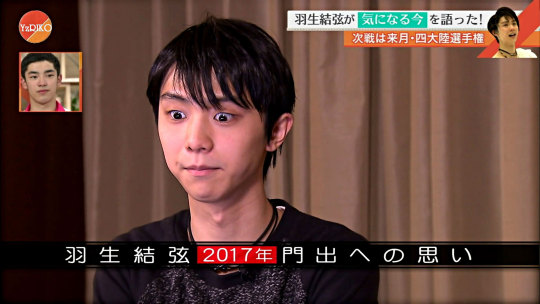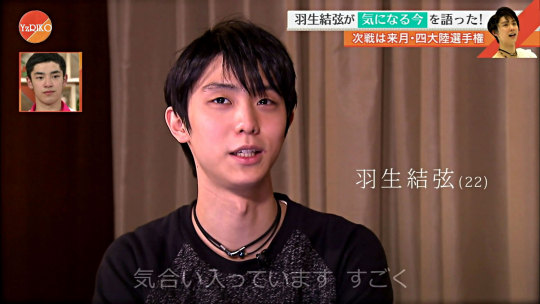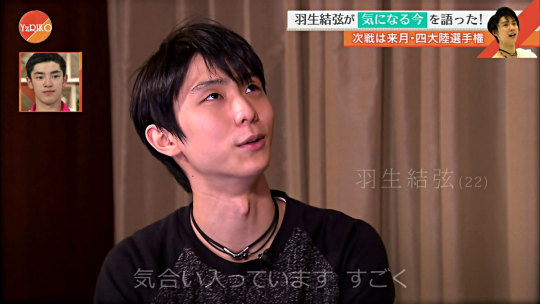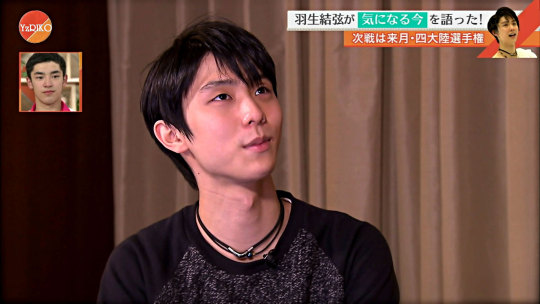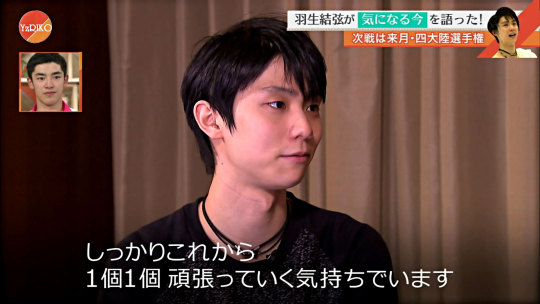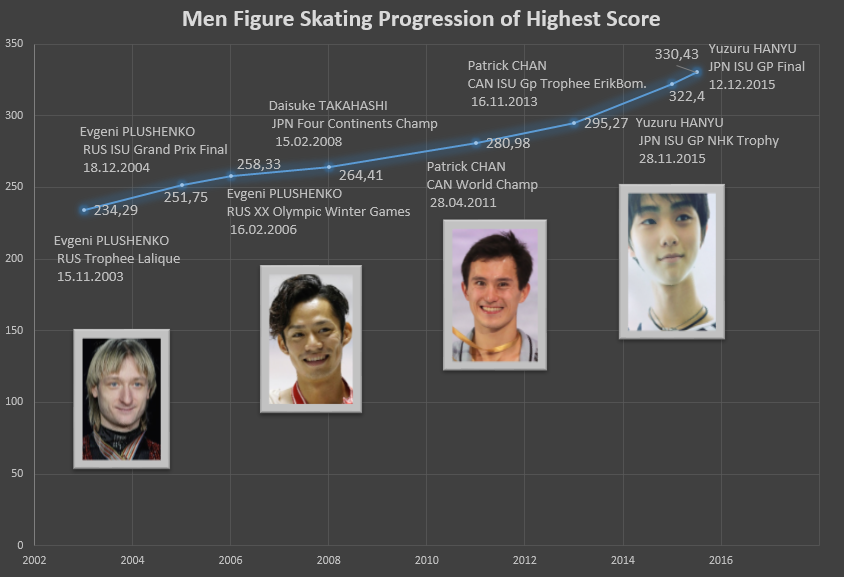–article by sports writer Toshimi Oriyama, from magazine ‘文藝春秋 2017年 02 月号’ (Feb 2017), translated by
yuzusorbet.tumblr.
(it’s a very long but good article)
Last year, in the figure skating Grand Prix Final (GPF) held in Marseille, France, Yuzuru Hanyu achieved a 4th consecutive victory, something that no one has done before. On the first day, his short programme (SP) was almost perfect and he was in 1st place, then 2 days later, for the free programme (FP), he made some mistakes. But he managed to escape the chase by younger skaters, Nathan Chen and Shoma Uno.
The 22 year-old, who is the Sochi Olympic gold medalist and who has since broken the world records a few times, thought back calmly about GPF 2016.
“As a goal, I am very proud of the 4th straight victory. But I am not satisfied with my performance. I am extremely 'kuyashii’ (frustrated/regretful) about the FP score which was in 3rd place. I did a good performance for SP and I thought if I did a fairly good one for FP, I could aim for world highest score; I need to review this point within myself.”
GPF is the high point of the first half of the season. It is a competition that shows the world’s best, similar to World Championship of the 2nd half. Hanyu’s 4th victory puts him on par with the 'emperor’ Evgeny Plushenko (Russia). However, for Hanyu, instead of the joy of victory, he felt more of the regret that he 'could not do a convincing performance’. And this ambition and hungriness is the mentality that is the source of Hanyu’s strength.
2010, Hanyu won the World Junior Championship, and the next season, he moved to the senior competitions. From that time, his supple and graceful performances already had a charm and the beauty of his jumps had a good reputation. Then, in 2011, in his hometown of Sendai, the Great East Japan Earthquake struck; that painful experience and recurring thoughts like “I think I will not be able to skate again” surely led him to grow as a person.
However, to possess that special mental strength to be able to stand at the highest point at the Olympics and to continue winning after that, there were 3 other turning points.
The presence of Patrick Chan (Canada) who was called 'the absolute champion’.
The 'kuyashii’ (regretful) gold medal at Sochi Olympics.
The accident at 2014 Cup of China.
Hanyu’s mental strength that could be seen in glimpses from the time of his debut, the 2013-2014 season added 'calmness’ and a 'spirit of study’ to that.
The year before, he had moved to the Cricket Club in Canada to train under Brian Orser and his abilities continued to blossom.
And there was a rival who was a big impetus for him. 3-time World champion Patrick Chan who also won GPF twice and was acknowledged to have the best skating skills in the world, plus huge battle strength on the big stage.
Hanyu faced Chan in 2 GP series competitions in 2013. The 1st one was Skate Canada where his score was lower than Chan’s by 27 points and the 2nd one was Trophee Eric Bompard where the gap was 32 points. He was 2nd place in both competitions and you could say it was a crushing defeat.
But these 2 straight losses caused Hanyu to change. Especially Chan’s clean performances at Trophee Eric Bompard that hit record scores for both SP and FP, “it was a trigger for me to look at my own abilities objectively”.
“I had nothing but respect and admiration for Patrick’s perfect performance. But at that competition, if both Patrick and I did perfect performances, I knew clearly how much of a gap there would be, and that made a big impact. At that time, I would have lost by about 5 points.”
No matter how perfectly he himself skated, there was a difference in the difficulty of jumps, the level of programme components and such; the reality was that if the opponent does not make mistakes, he (Hanyu) would lose. That was thrusted clearly at him in the form of results.
“To cover the gap between Patrick and me, there was a need to increase PCS. To do that, I had to relook at /improve my skating skills which is the foundation, and I had to be more aware of maintaining my expressive abilities during the run-through practice of the physically demanding programme. In addition, I had to get points for spins and steps, and higher GOE for jumps, I thought about all these things.”
Being conscious of the specific scores, having a strategy in the programme, he also came to have a deeper understanding of the meaning behind the practice that Coach Orser laid out for attaining high scores.
Also, he got a hint for his own growth from the words that Chan said.
During the press conference after the competition, sitting next to him, Chan was explaining in detail to the reporters how he was mindful about the way he used his body to express the music. Hanyu listened and “it was a good reference for my own performance”. After moving to Toronto, he had started learning English, so he probably understood the words between Chan and the reporter.
Hanyu at that time was only 19 (t/n. it was just before his 19th birthday). I have interviewed many athletes, not just figure skaters. But at press conferences of international competitions where foreign reporters overwhelm, even I feel that the nervousness is very pressurising. To turn that situation into a “learning area”, that 'spirit of desire’ deserves special mention.
When he received that impetus from Chan, at the same time there were words that made one feel the power of Hanyu’s inquiring mind. “Surrounded by reporters and being interviewed on-the-spot is useful,” he said.
“After a competition, media people surround me; in the exchange that I have with reporters, I can look back at my performance and talk about it right after I finish performing. I like to analyse my own performance, so it is very stimulating to have questions flying at me from various view points, and also, it enables me to think in a way that’s different from before. Interviews become a place for learning.”
Even veteran athletes find it hard to say something like this. It clearly shows his youth, and stemming from it, his frankness and inquiring mind.
The result of the impetus and learning points from Chan was seen quickly, at the GPF merely 3 weeks after the crushing defeat at Eric Bompard. Hanyu rewrote the world’s highest score for SP that was previously held by Chan, and his FP score was also his personal best. His total score was 13 points more than Chan and he won his first senior GPF.
Using the gold medal
Maintaining that energy/momentum was the key to the Olympic stage 2 months later.
His SP was a masterpiece and, for the 1st time in history, the score went above 100. He was in 1st place with 101.45. But for the FP, he fell at the 4S and 3F. He thought Chan who was 2nd after SP, would overtake him to be the winner. However, Chan also made mistakes and the result was that Hanyu won the gold medal.
“When I finished my performance, I thought the gold medal was not possible anymore. The failure of my FP made me realise the fearfulness of the Olympics, and I also felt the weight of the Olympics. I don’t know why but somehow my body could not move at all.”
The Olympic stage that’s once in 4 years. Participating for the first time and suddenly, he stood right at the top. Winning the first figure skating men’s gold medal for Japan, Hanyu decided immediately after that he would continue to evolve.
“In these next 4 years from now on, the pressure and the attention from the media and such, I think there will be a lot more of these extra things following me. In competitions, judges will not give me a higher evaluation just because I am an Olympic champion. How others see me does not matter. I myself must give a performance that’s worthy of a champion and really receive a gold medal evaluation. In this sense, I must make use of the position of 'Olympic Champion’. Because it is a chance for me to keep putting pressure on myself. Like telling myself, 'Oi, show us an Olympic champion-like performance! Hanyu Yuzuru, show some growth!’ (laughs)”
Then, the performance that left regrets on the Olympic stage, it became the will and desire to move forward to the next step. Thinking back, he said,
“For the FP at Sochi, if I had landed the quad salchow and done a no-miss performance, I would very likely be dragged by the Olympic champion result. Precisely because the Sochi gold medal was one that was carrying regretful thoughts, that’s why the present me exists. I got the Olympic gold medal at such a young age, and in addition, I received some problems to work on. As an athlete, this was really a lavish situation.”
A shocking collision
The season after Sochi, just as he said, he grew further, stepping his foot into unknown territory.
To prepare for the coming era of quads, he put a 4S and two 4Ts in his FP, and one of the 4T was in the 2nd half where more points would be given. To get used to this, he also put a 4T in the 2nd half of his SP. He spoke about the objective.
“It’s also preparation/groundwork for incorporating other kinds of quad jumps in future.”
However, his efforts met an unexpected setback at the 1st competition of the season, Cup of China (CoC). In the 6 minute warm-up before FP, there was an accident; he and Han Yan of China crashed into each other.
Blood could be seen dripping from Hanyu’s head (t/n. his chin) and there were screams from the audience. Coach Orser quickly called the doctors (t/n. U.S. team doctors came to help). After checking him, the doctors said there were no signs of concussion, but people around him told him not to skate.
However, Hanyu was stubborn. “I will skate.”
Orser reluctantly sent him into the rink, but of course, Hanyu could not do his performance properly. His whole body was battered and there was no strength, he fell a total of 5 times. What was pushing him on was his will power alone.
After this, he continued to compete until GPF, but the venture to make his performance one rank higher had to be shelved.
At the end of the year, due to intermittent abdominal pain, he went to the hospital for a checkup. He was found to have Urachal Remnant Disorder and underwent surgery. After that, he needed to rest and recover for one month. When he started to train again, he sprained his right ankle. Due to all this, he was 2nd in the World Championship that he was aiming for a 2nd straight victory. Even though he had a 2nd straight win at GPF, to him it was a year of stagnation.
After Worlds, he looked back on the season that was troubled by many accidents.
“The injuries and illnesses were hard on not only the body but on the mind/spirit as well. But even under those circumstances, I could at the very least leave some results; to me this experience was not not totally negative.
For the accident at CoC, there was insufficient attention on my part, so it triggered a re-looking at the way I entered into the competition, including the way I manage my body condition. And also, more than anything else, the way I was supported by my coaches and the people around me, it was a season where I felt it even more deeply than the Olympic season. All these experiences will be a plus in my competitive skating life, and also in my 2nd career after I retire.”
He also thought about the development of figure skating as a competitive sport. Based on his own accident, he said, “figure skating is a sport with an element of danger that can be a risk to life –that this is known to more people is a plus to the development of the sport.” He also said he was happy that it gave rise to a tide of thoughts on what is necessary to prevent concussions and other life-threatening accidents.
No matter what 'minus’ elements there are, he transforms them into 'plus’, seizes them and looks ahead. As a reporter, this attitude of his amazes me from time to time.
Even when he is bleeding from his head, he is determined that he must go on with the competition; it was also due to the pride that comes because of achieving the title of Olympic champion (t/n. 'pride’ in the positive meaning). Hanyu very naturally has that on him.
The next season, 2015-2016, Hanyu once again challenged the programmes with a quad in the 2nd half.
In the 1st competition, Skate Canada, he was too conscious of the “quad in 2nd half” and made some unthinkable mistakes. As a result, he lost to Chan who had just returned from a year of rest.
However, it was different from before. Chan’s programme layout was lower in difficulty than his own, and he lost to Chan’s 'safe driving’ performance. It made him check if the direction and path that he was going was correct.
“Seeking even greater evolution is what is most like me.”
For his SP, in exchange for not having a quad in the 2nd half, he put 2 quads in the first half, 4S and 4T, making it even more difficult.
No matter what, he wants to challenge himself and this also raised his concentration power. At the next competition, he scored 322.40, the first above-300 points in history. And then at GPF, he broke his own records with 330.43. With difficult programmes and clean performances back-to-back, it was a stunning victory over rivals Chan and Fernandez.
Storming through the 300-mark which no one has even touched before, Hanyu’s mental aspect has also reached that high level which normal people cannot comprehend.
“At Sochi Olympics, my free skate performance failed. When I finished, I thought 'the gold medal is gone’. And at that moment, I realised, 'ah, so I was conscious of the gold medal and I was nervous’. This time, that experience at Sochi was put to good use. Before entering the venue, I was aware that I was thinking 'I want to surpass 300 points’. So first, I acknowledged that I am thinking about that and putting pressure on myself, and then, 'if so, I have to do this’ and I think I controlled well my mental state.”
In a situation of being closely chased, the strength to look at himself calmly brought forth a spectacular feat.
For the 2016-2017 season, he decided on new challenges, having a quad loop in both SP and FP and a layout that’s more difficult. When 2016 started, the pain in his left foot (t/n. lisfranc injury) became worse, and after Worlds, even walking was not allowed and this restriction period continued for one and a half months. But in spite of that, he still aimed for further evolution.
Connection with the audience
But it was also an inevitable decision. The previous season, Boyang Jin (China) had 3 types of quads, including the most difficult (of the quads jumped til now) quad lutz, and 6 quads in total for SP and FP and he was 3rd in Worlds. Then Shoma Uno did the world’s 1st quad flip in the Team Challenge Cup in April.
Hanyu himself opened up the frontier of 300 points. Rising young skaters have quads as weapons to challenge him. And it’s not just about having quads, it is about the number of quads and how well they are done; this era of competition has come.
This season, in addition to jumps and layout, Hanyu is widening his range of expression. This can be said as his real value/ ability.
His SP is Prince’s 'Let’s Go Crazy’. It’s rock music that brings to mind his Sochi Olympics SP 'Parisienne Walkways’. FP is 'Hope and Legacy’ which is a combination of 2 pieces of piano music from Joe Hisaishi that Hanyu likes very much. They are 2 contrasting types of music. SP is an uptempo music that Hanyu is very good at; FP piano music has a rhythm and sounds that are harder to grasp for jump timing.
Having 2 completely opposite types of music was for raising his own expressive abilities. At GP Final which he won for the 4th consecutive time, he spoke of being aware of a 'connection with the audience’.
“This season’s SP, I am performing it like a rock star having a live concert, so it’s a programme that is not possible without the audience. In France (GPF), the audience also became very excited and it was very fun. Then for the FP, I could perform while feeling the music with my whole body. It’s different from the SP, it’s not a programme where the audience becomes more and more excited and clap and go WA!!! But during the performance, I could feel the gaze of the audience, and when I did my jumps, I could see there were people praying for me. I connected with the audience, in other words, our feelings became one, and I felt this happiness.”
Something that is in the beat and the meaning of the lyrics of Prince; abandoning yourself to the piano music of Joe Hisaishi and feeling the wind, the trees, the air and other things of nature. Sharing with the audience the world that you express through skating, wanting to create a programme that’s like having a conversation with the audience – that is one of the complete forms of figure skating which is sports and also art.
From TV and books etc, Hanyu studies the ways of thinking of athletes from other sports and reflects them in skating. He often says that this is his weapon. Recently, gymnast Kohei Uchimura who won a consecutive victory at Rio Olympics said, “I had to win, it was good.” Words in which you could feel the heavy pressure on someone who stood at the top, those words left a deep impression on him. Without being imprisoned by existing boundaries, he wants to pursue figure skating further and further, this is his thinking.
“Receiving the programmes from the choreographer, integrating jumps into it and performing it, that is my job/work. When all the jumps are completed beautifully, then it can be called a real performance. That is why I am so regretful (kuyashii); while adding in a new quad and doing a layout that’s more difficult than last season, I am still not able to make a new personal best score this season. If I speak my true feelings, I want to raise my scores and become the Yuzuru Hanyu that no one can catch.”
For his own growth, for figure skating as a sport, his desire/greed never fades, and this is his true strength as a skater. And it can also be said that this is why he makes us feel that for him there are infinite possibilities.
– original article by sports writer Ms.Toshimi Oriyama; very sorry if I didn’t translate it well.
–thanks to __哎喲喂__ (weibo) for the article.

